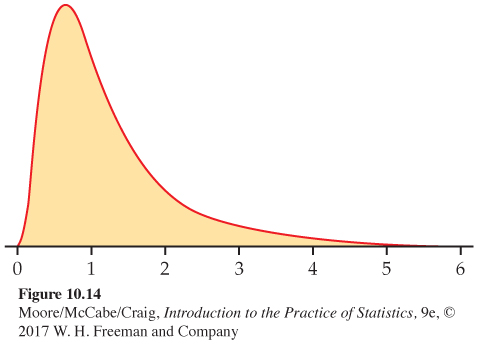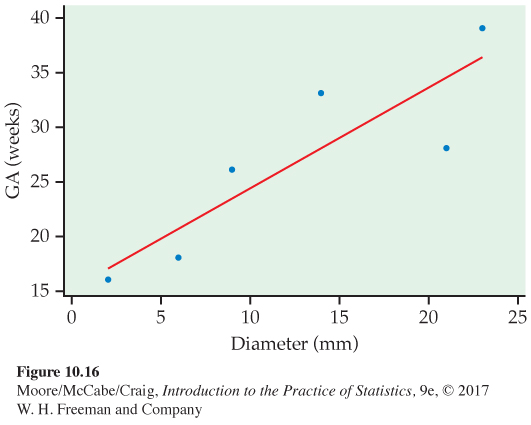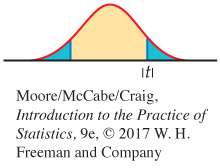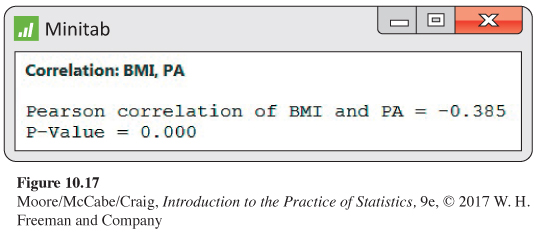10.2 10.2 More Detail about Simple Linear Regression
When you complete this section, you will be able to:
• Construct a linear regression analysis of variance (ANOVA) table.
• Use an ANOVA table to perform the ANOVA F test and draw appropriate conclusions regarding H0: β1 = 0.
• Use an ANOVA table to compute the square of the sample correlation and provide an interpretation of it in terms of explained variation.
• Perform, using a calculator, inference in simple linear regression when a computer is not available.
• Distinguish the formulas for the standard error that we use for a confidence interval for the mean response and the standard error that we use for a prediction interval when x = x*.
• Test the hypothesis that there is no linear association in the population and summarize the results.
• Explain the close connection between the tests H0: β1 = 0 and H0: ρ = 0.
In this section, we study three topics. The first is analysis of variance for regression. If you plan to read Chapter 11 on multiple regression, you should study this material. The second topic concerns computations for regression inference. The section we just completed assumes that you have access to software or a statistical calculator. Here we present and illustrate the use of formulas for the inference procedures. Finally, we discuss inference for correlation.
583
Analysis of variance for regression
The usual computer output for regression includes additional calculations called analysis of varianceanalysis of variance. Analysis of variance, often abbreviated ANOVA, is essential for multiple regression (Chapter 11) and for comparing several means (Chapters 12 and 13). Analysis of variance summarizes information about the sources of variation in the data. It is based on the
DATA = FIT + RESIDUAL
framework (page 560).
The total variation in the response y is expressed by the deviations . If these deviations were all 0, all observations would be equal and there would be no variation in the response. There are two reasons the individual observations are not all equal to their mean .
1. The responses correspond to different values of the explanatory variable x and will differ because of that. The fitted value estimates the mean response for . The differences reflect the variation in mean response due to differences in the . This variation is accounted for by the regression line because the ’s lie exactly on the line.
2. Individual observations will vary about their mean because of variation within the subpopulation of responses for a fixed xi. This variation is represented by the residuals that record the scatter of the actual observations about the fitted line.
The overall deviation of any y observation from the mean of the y’s is the sum of these two deviations:
In terms of deviations, this equation expresses the idea that DATA = FIT + RESIDUAL.
Several times, we have measured variation by an average of squared deviations. If we square each of the preceding three deviations and then sum over all n observations, it can be shown that the sums of squares add:
We rewrite this equation as
SST = SSM + SSE
where
584
The SS in each abbreviation stands for sum of squares,sum of squares and the T, M, and E stand for total, model, and error, respectively. (“Error’’ here stands for deviations from the line, which might better be called “residual’’ or “unexplained variation.’’) The total variation, as expressed by SST, is the sum of the variation due to the straight-
If H0: β1 = 0 were true, there would be no subpopulations, and all of the y’s should be viewed as coming from a single population with mean μy. The variation of the y’s would then be described by the sample variance
The numerator in this expression is SST. The denominator is the total degrees of freedom, or simply DFT.
degrees of freedom, p. 40
Just as the total sum of squares SST is the sum of SSM and SSE, the total degrees of freedom DFT is the sum of DFM and DFE, the degrees of freedom for the model and for the error:
DFT = DFM + DFE
The model has one explanatory variable x, so the degrees of freedom for this source are DFM = 1. Because DFT = n − 1, this leaves DFE = n − 2 as the degrees of freedom for error.
For each source, the ratio of the sum of squares to the degrees of freedom is called the mean squaremean square, or simply MS. The general formula for a mean square is
Each mean square is an average squared deviation. MST is just , the sample variance that we would calculate if all of the data came from a single population. MSE is also familiar to us:
It is our estimate of σ2, the variance about the population regression line.
SUMS OF SQUARES, DEGREES OF FREEDOM, AND MEAN SQUARES
Sums of squares represent variation present in the responses. They are calculated by summing squared deviations. Analysis of variance partitions the total variation between two sources.
The sums of squares are related by the formula
SST = SSM + SSE
That is, the total variation is partitioned into two parts, one due to the model and one due to deviations from the model.
585
Degrees of freedom are associated with each sum of squares. They are related in the same way:
DFT = DFM + DFE
To calculate mean squares, use the formula
In Section 2.4 (page 116), we noted that r2interpretation of r 2 is the fraction of variation in the values of y that is explained by the least-
Because SST is the total variation in y and SSM is the variation due to the regression of y on x, this equation is the precise statement of the fact that r2 is the fraction of variation in y explained by x in the linear regression.
The ANOVA F test
The null hypothesis H0: β1 = 0 that y is not linearly related to x can be tested by comparing MSM with MSE. The ANOVA test statistic is an F statisticF statistic,
When H0 is true, this statistic has an F distribution with 1 degree of freedom in the numerator and n − 2 degrees of freedom in the denominator. These degrees of freedom are those of MSM and MSE. When β1 ≠ 0, MSM tends to be large relative to MSE. So, large values of F are evidence against H0 in favor of the two-
The F distributionsF distributions are a family of distributions with two parameters: the degrees of freedom of the mean square in the numerator and denominator of the F statistic. The F distributions are another of R. A. Fisher’s contributions to statistics and are called F in his honor. Fisher introduced F statistics for comparing several means. We meet these useful statistics in Chapters 14 and 15.
The numerator degrees of freedom are always mentioned first. Interchanging the degrees of freedom changes the distribution, so the order is important. Our brief notation will be F(j, k) for the F distribution with j degrees of freedom in the numerator and k in the denominator. The F distributions are not symmetric but are right-
We recommend using statistical software for calculations involving F distributions. We do, however, supply a table of critical values similar to Table D. Tables of F critical values are awkward because a separate table is needed for every pair of degrees of freedom j and k. Table E in the back of the book gives upper p critical values of the F distributions for p = 0.10, 0.05, 0.025, 0.01, and 0.001.
586

ANALYSIS OF VARIANCE F TEST
In the simple linear regression model, the hypotheses
H0: β1 = 0
Ha: β1 ≠ 0
are tested by the F statistic

The P-value is the probability that a random variable having the F(1, n − 2) distribution is greater than or equal to the calculated value of the F statistic.
The F statistic tests the same null hypothesis as one of the t statistics that we encountered earlier in this chapter, so it is not surprising that the two are related. It is an algebraic fact that t2 = F in this case. For linear regression with one explanatory variable, we prefer the t form of the test because it more easily allows us to test one-
The ANOVA calculations are displayed in an analysis of variance table, often abbreviated ANOVA tableANOVA table. Here is the format of the table for simple linear regression:
| Source | Degrees of freedom | Sum of squares | Mean square | F |
|---|---|---|---|---|
| Model | 1 | SSM/DFM | MSM/MSE | |
| Error | n − 2 | SSE/DFE | ||
| Total | n − 1 | SST/DFT |
587
EXAMPLE 10.15
Interpreting SAS output for BMI and physical activity. The output generated by SAS for the physical activity study in Example 10.3 is given in Figure 10.15. Note that SAS uses the labels Model and Error but replaces Total with Corrected Total. Other statistical software packages may use slightly different labels. The F statistic is 17.10; the P-value is given as < 0.0001. There is strong evidence against the null hypothesis that there is no relationship between BMI and average number of steps per day (PA).

![]()
Now look at the output for the regression coefficients. The t statistic for PA is given as −4.13. If we square this number, we obtain the F statistic (accurate up to roundoff error). The value of r2 is also given in the output. Average number of steps per day explains only 14.9% of the variability in BMI. Strong evidence against the null hypothesis that there is no relationship does not imply that a large percentage of the total variability is explained by the model.
USE YOUR KNOWLEDGE
Question 10.23
10.23 Reading linear regression outputs. Figure 10.4 (pages 562–
588
Calculations for regression inference
We recommend using statistical software for regression calculations. With time and care, however, the work is feasible with a calculator. We will use the following example to illustrate how to perform inference for regression analysis using a calculator.
EXAMPLE 10.16
Umbilical cord diameter and gestational age. Knowing the gestational age (GA) of a fetus is important for biochemical screening tests and planning for successful delivery. Typically GA is calculated as the number of days since the start of the woman’s last menstrual period (LMP). However, for women with irregular periods, GA is difficult to compute, and ultrasound imaging is often used. In the search for helpful ultrasound measurements, a group of Nigerian researchers looked at the relationship between umbilical cord diameter (mm) and gestational age based on LMP (weeks).8 Here is a small subset of the data:
| Umbilical cord diameter (x) | 2 | 6 | 9 | 14 | 21 | 23 |
| Gestational age (y) | 16 | 18 | 26 | 33 | 28 | 39 |
The data and the least-

![]()
We begin our regression calculations by fitting the least-
589
Preliminary calculations After examining the scatterplot (Figure 10.16) to verify that the data show a straight-
EXAMPLE 10.17
Summary statistics for gestational age study. We start by making a table with the mean and standard deviation for each of the variables, the correlation, and the sample size. These calculations should be familiar from Chapters 1 and 2. Here is the summary:
| Variable | Mean | Standard deviation |
Correlation | Sample size |
|---|---|---|---|---|
| Diameter | sx = 8.36062 | r = 0.87699 | n = 6 | |
| Gestational age | sy = 8.75595 |
These quantities are the building blocks for our calculations.
We will need one additional quantity for the calculations to follow. It is the expression . We obtain this quantity as an intermediate step when we calculate sx. You could also find it using the fact that . You should verify that the value for our example is
Our first task is to find the least-
EXAMPLE 10.18
Computing the least-
= 0.91846
The intercept is
= 26.66667 − (0.91846)(12.5)
= 15.18592
The equation of the least-
This is the line shown in Figure 10.16.
We now have estimates of the first two parameters, β0 and β1, of our linear regression model. Next, we find the estimate of the third parameter, σ: the standard deviation s about the fitted line. To do this we need to find the predicted values and then the residuals.
590
EXAMPLE 10.19
Computing the predicted values and residuals. The first observation is a diameter of x = 2. The corresponding predicted value of gestational age is
= 15.1859 + (0.9185)(2)
= 17.023
and the residual is
= 16 − (17.023)
= −1.023
The residuals for the other diameters are calculated in the same way. They are −2.697, 2.548, 4.955, −6.474 and 2.689, respectively. Notice that the sum of these six residuals is zero (except for some roundoff error). When doing these calculations by hand, it is always helpful to check that the sum of the residuals is zero.
EXAMPLE 10.20
Computing s2. The estimate of σ2 is s2, the sum of the squares of the residuals divided by n − 2. The estimated standard deviation about the line is the square root of this quantity.
= 22.127
So the estimate of the standard deviation about the line is
USE YOUR KNOWLEDGE
Question 10.24
10.24 Computing residuals. Refer to Examples 10.17, 10.18, and 10.19.
(a) Show that the least squares line goes through .
(b) Verify that the other five residuals are as stated in Example 10.19.
Inference for slope and intercept Confidence intervals and significance tests for the slope β1 and intercept β0 of the population regression line make use of the estimates b1 and b0 and their standard errors. Some algebra and the rules for variances establishes that the standard deviation of b1 is
rules for variances, p. 258
591
Similarly, the standard deviation of b0 is
To estimate these standard deviations, we need only replace σ by its estimate s.
STANDARD ERRORS FOR ESTIMATED REGRESSION COEFFICIENTS
The standard error of the slope b1 of the least-
The standard error of the intercept b0 is
The plot of the regression line with the data in Figure 10.16 shows a very strong relationship, but our sample size is small. We assess the situation with a significance test for the slope.
EXAMPLE 10.21
Testing the slope. First we need the standard error of the estimated slope:
= 0.2516
To test
H0: β1 = 0
Ha: β1 ≠ 0
calculate the t statistic:
Using Table D with n − 2 = 4 degree of freedom, we conclude that 0.02 < P < 0.04. The exact P-value obtained from software is 0.022. The data provide evidence in favor of a linear relationship between gestational age and umbilical cord diameter (t = 3.65, df = 4, 0.02 < P < 0.04).
![]()
Two things are important to note about this example. First, it is important to remember that we need to have a very large effect if we expect to detect a slope different from zero with a small sample size. The estimated slope is more than 3.5 standard deviations away from zero, but we are not much below the 0.05 standard for statistical significance. Second, because we expect gestational age to increase with increasing diameter, a one-
592
The significance test tells us that the data provide sufficient information to conclude that gestational age and umbilical cord diameter are linearly related. We use the estimate b1 and its confidence interval to further describe the relationship.
EXAMPLE 10.22
Computing a 95% confidence interval for the slope. Let’s find a 95% confidence interval for the slope β1. The degrees of freedom are n − 2 = 4, so t* from Table D is 2.776. We compute
= 0.9185 ± 0.6984
The interval is (0.220, 1.617). For each additional millimeter in diameter, the gestational age of the fetus is expected to be 0.220 to 1.617 weeks older.
In this example, the intercept β0 does not have a meaningful interpretation. An umbilical cord diameter of zero millimeters is not realistic. For problems where inference for β0 is appropriate, the calculations are performed in the same way as those for β1. Note that there is a different formula for the standard error, however.
Confidence intervals for the mean response and prediction intervals for a future observation When we substitute a particular value x* of the explanatory variable into the regression equation and obtain a value of we can view the result in two ways:
1. We have estimated the mean response μy.
2. We have predicted a future value of the response y.
The margins of error for these two uses are often quite different. Prediction intervals for an individual response are wider than confidence intervals for estimating a mean response. We now proceed with the details of these calculations. Once again, standard errors are the essential quantities. And once again, these standard errors are multiples of s, our basic measure of the variability of the responses about the fitted line.
STANDARD ERRORS FOR AND
The standard error of is
The standard error for predicting an individual response is
593
Note that the only difference between the formulas for these two standard errors is the extra 1 under the square root sign in the standard error for prediction. This standard error is larger due to the additional variation of individual responses about the mean response. This additional variation remains regardless of the sample size n and is the reason that prediction intervals are wider than the confidence intervals for the mean response.
For the gestational age example, we can think about the average gestational age for a particular subpopulation, defined by the umbilical cord diameter. The confidence interval would provide an interval estimate of this subpopulation mean. On the other hand, we might want to predict the gestational age for a new fetus. A prediction interval attempts to capture this new observation.
EXAMPLE 10.23
Computing a confidence interval for m. Let’s find a 95% confidence interval for the average gestational age when the umbilical cord diameter is 10 millimeters. The estimated mean age is
= 15.1859 + (0.9185)(10)
= 24.371
The standard error is
= 2.021
To find the 95% confidence interval, we compute
= 24.371 ± 5.610
The interval is 18.761 to 29.981 weeks of age. This is a pretty wide interval given gestation lasts for about 40 weeks.
Calculations for the prediction intervals are similar. The only difference is the use of the formula for in place of . This results in a much wider interval. In fact, the interval is slightly more than 28 weeks in width. Even though a linear relationship was found statistically significant, it does not appear umbilical cord diameter is a precise predictor of gestational age.
Inference for correlation
The correlation coefficient is a measure of the strength and direction of the linear association between two variables. Correlation does not require an explanatory-
correlation, p. 101
594
The correlation between the variables x and y when they are measured for every member of a population is the population correlationpopulation correlation. As usual, we use Greek letters to represent population parameters. In this case ρ (the Greek letter rho) is the population correlation.
When ρ = 0, there is no linear association in the population. In the important case where the two variables x and y are both Normally distributed, the condition ρ = 0 is equivalent to the statement that x and y are independent. That is, there is no association of any kind between x and y. (Technically, the condition required is that x and y be jointly Normal variablesjointly Normal variables. This means that the distribution of x is Normal and also that the conditional distribution of y, given any fixed value of x, is Normal.) We, therefore, may wish to test the null hypothesis that a population correlation is 0.
TEST FOR A ZERO POPULATION CORRELATION
To test the hypothesis H0: ρ = 0, compute the t statistic
where n is the sample size and r is the sample correlation.
In terms of a random variable T having the t(n − 2) distribution, the P-value for a test of H0 against
Ha: ρ > 0 is P(T ≥ t) 
Ha: ρ < 0 is P(T ≤ t) 
Ha: ρ ≠ 0 is 2P(T ≥ |t|) 
Most computer packages have routines for calculating correlations, and some will provide the significance test for the null hypothesis that ρ is zero.
EXAMPLE 10.24
Correlation in the physical activity study. The Minitab output for the physical activity example appears in Figure 10.17. The sample correlation between BMI and the average number of steps per day (PA) is r = −0.385. Minitab calls this a Pearson correlation to distinguish it from other kinds of correlations that it can calculate. The P-value for a two-
595

If we wanted to test the one-
If your software does not give the significance test, you can do the computations easily with a calculator.
EXAMPLE 10.25
Correlation test using a calculator. The correlation between BMI and PA is r = −0.385. Recall that n = 100. The t statistic for testing the null hypothesis that the population correlation is zero is
= −4.13
The degrees of freedom are n − 2 = 98. From Table D, we conclude that P < 0.0001. This agrees with the Minitab output in Figure 10.17, where the P-value is given as 0.000. The data provide clear evidence that BMI and PA are related.
There is a close connection between the significance test for a correlation and the test for the slope in a linear regression. Recall that
From this fact, we see that if the slope is 0, so is the correlation, and vice versa. It should come as no surprise to learn that the procedures for testing H0: β1 = 0 and H0: ρ = 0 are also closely related. In fact, the t statistics for testing these hypotheses are numerically equal. That is,
Check that this holds in both of our examples.
In our examples, the conclusion that there is a statistically significant correlation between the two variables would not come as a surprise to anyone familiar with the meaning of these variables. The significance test simply tells us whether or not there is evidence in the data to conclude that the population correlation is different from 0. The actual size of the correlation is of considerably more interest. We would, therefore, like to give a confidence interval for the population correlation. Unfortunately, most software packages do not perform this calculation. Because hand calculation of the confidence interval is very tedious, we do not give the method here.9